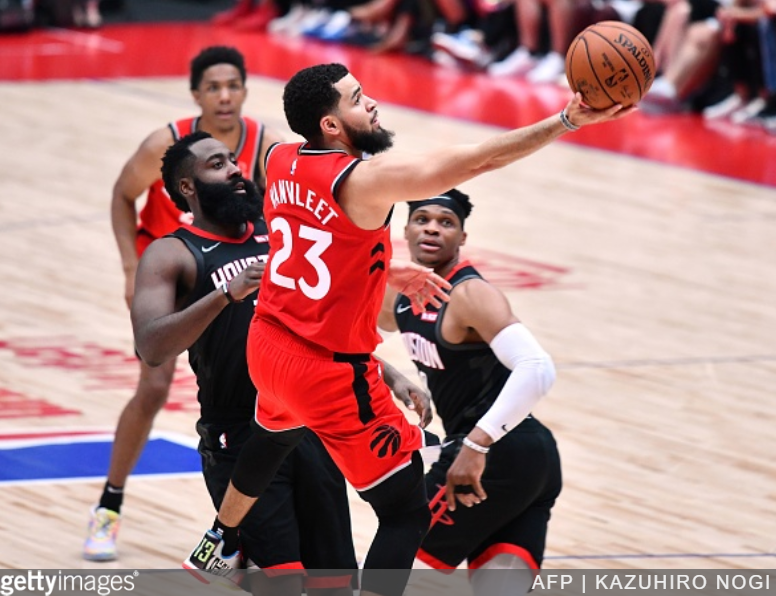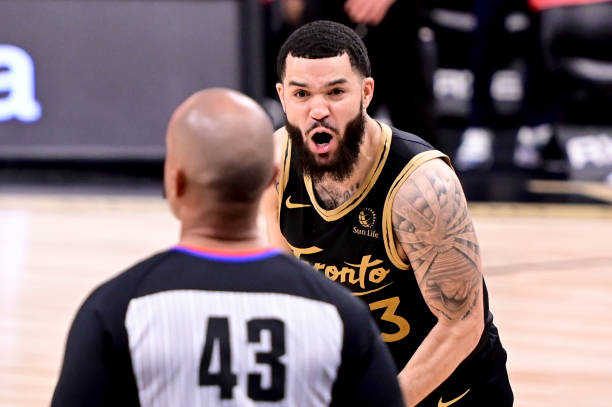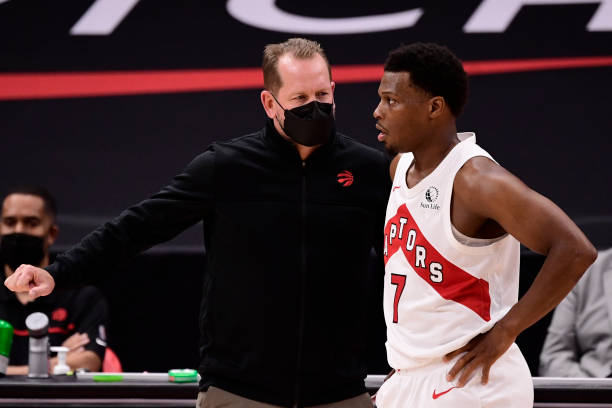May 1, 2021 may go down as an important date in the history of Fred VanVleet. The key moment came during a seemingly insignificant pick and roll in the first quarter against the Utah Jazz. VanVleet dribbled inside the arc from the wing and snaked into the middle of the lane. When he emerged, two-time Defensive Player of the Year Rudy Gobert loomed in front of him. VanVleet prefers to take shots at the rim, but Gobert and his 7-foot-9 wingspan blotted out the rim from the sight of VanVleet and his 6-foot-2 wingspan. A dilemma. So VanVleet walked directly into a runner, which he dripped off the glass for two points.
It may have seemed like an insignificant moment, but VanVleet has long been a midrange-averse player. He’s only ever taken around a quarter of his shots from the midrange, putting him below the 30th-percentile for midrange frequency for his position every season of his career. Yet against the Jazz, that runner was his third shot of the game, and the third he’d attempted from the midrange. He finished with 13 2-pointers attempted from further than four feet, making six.
I had actually asked VanVleet about his proclivity for injury after his previous game. And he mentioned turning to the midrange in search of an answer.
“I’m certainly not trying to hurt myself,” he said. “But, yeah, I could change the way I play for sure, it’s what got me this far so it’d be something to revisit in the off-season and add more mids, floaters, runners and stuff in the paint. I’m gonna be who I’m gonna be and we’ll revisit that as a franchise this summer, I’ll talk to Nick, I’ll talk to management and see if there’s any suggestions on me switching my playstyle but I don’t plan on changing any time soon. It’s got me to this point and I definitely can get better, there’s a lot of room for improvement and I plan to keep getting better each day and each year.”
VanVleet’s 13 midrange attempts against Utah set a career high by a wide margin. What was the second highest, you might ask? It came only two games later, as he attempted 10 midrange shots against the Washington Wizards on May 6. If it feels like VanVleet has changed his game recently, it’s because he has.
I asked Nick Nurse if VanVleet’s shift to the floater is intentional, and without giving up too many details, he said that “yes, it is… The intention is the [midrange] shot is there. I think that’s what we’ve been seeing as opportunities [for VanVleet].”
The shot certainly has been there for VanVleet; defenders hunt his layups like predators in search of blocks. That has led to VanVleet being shy at the rim; he actually leads the league in passing out of his drives, passing on 60.4 percent. He’s been in the top five for that stat every year of his career, though he’s only broken the 60 percent barrier for the first time this season. And while passing after touching the paint is good, VanVleet needs to be more of a scoring threat to fully weaponize his drives. Midrange shots offer that. And no matter how much contact VanVleet seems to be taking around the rim, he isn’t getting more freebies at the line. His free throw rate has actually dropped from last season. The midrange allows VanVleet to avoid blocks, contact, referees: he can skip the rat race and just toss the ball on the rim, letting his touch determine his fate. The midrange opens up new pastures within which VanVleet can roam. I wrote a piece in March about VanVleet’s spectacular season, and it was clear even at that point that he had begun the process of expanding his game into the midrange.
Pull-up shooting gives him even more ways to be effective with the ball and more ways to find his shot against different types of defenses. The mid-range game isn’t his primary threat, but it’s enough of one to punish opponents for overplaying him while also creating more opportunities for himself in the areas in which he thrives.
That, however, was about long twos. VanVleet’s addition to his game of short twos changes the math. There’s a huge gap, analytically, between a 20-foot pullup jumper and an eight-foot runner. The runner may fall into the category of the anti-modern, but there are plenty of reasons why it’s an important tool to have in the bag. That goes doubly for a player in VanVleet who is currently shooting exactly his career average at the rim, a piddling 51 percent. If he struggles to finish at the rim, VanVleet can adapt by shooting earlier, before his defender tracks his shot. He can take off-beat shots, alternating his pace. He can create contact on the ground. He can put more arc on his shots, more flavour. He can wrong-foot defenders. All those tricks have been part and parcel of VanVleet’s expansion into short midrange territory.
And he continues to sharpen his stockpile of short midrange munitions.
On top of the strategic benefits, VanVleet himself explained perhaps the biggest reason why he’s taking midrangers — to stay healthy. This is a lost season, in that the highest-win outcome has only a tiny chance of putting Toronto in the playoffs, where they’d quickly be bounced. And the lowest-win outcome would yield a high draft pick. So the Raptors don’t exactly want VanVleet to wreck his body chasing wins at the moment, and that’s when he’s even playing — no guarantee that’ll happen in the next handful of games. Everyone on the Raptors is currently stretching his legs. Pascal Siakam continues working on his jumper. While OG Anunoby was playing, his off-the-dribble game was thriving. Malachi Flynn is receiving the most consistent run of his career and has been working on throwing lobs and getting to the rim. VanVleet is stretching his game away from the rim, averaging a shot distance of 18.3 feet this year, the longest by far of his career. He is able to expand his game while making sure he doesn’t hurt himself during the most meaningless stretch of games of his career.
In chase of his future, VanVleet is embracing the league’s past. He’s always been a player who does things his own way. For a long time, that way was best defined as hurling himself at top speed towards, and hopefully through, any and all obstacles. It’s how he ended up on the ground, short a tooth, bleeding from the eye in the NBA Final. It’s also how he has ended up with ankle, wrist, leg, back, and shoulder injuries, to name a few, for the majority of his career. VanVleet is an All-Star-caliber player when he’s healthy. He just needs to stay that way. Spending more time in the midrange helps.
Against the Wizards, VanVleet had a chance in overtime to pull the Raptors within one. It came on an uncontested runner, and he missed it.
The Raptors failed to overcome the deficit and eventually lost their “last chance saloon” game to the Wizards. The season is now effectively over. VanVleet made only two of his 10 midrange shots against the Wizards. Adding new elements to his game is a work in progress, of course. There will be bumps in the road. Better that they come now when the games don’t matter — which is one reason why VanVleet may play in a few more games this season rather than shut down his year entirely. But there are strategic reasons why VanVleet is turning to the midrange. It’s an intentional decision made by him and the team meant to unlock his offense. The Raptors of course lost both games to the Jazz and Wizards, so our small sample size looks poorly upon this new VanVleet offensive shift. Don’t be fooled, though. The more VanVleet expands his offensive arsenal, the more equipped he will be to succeed. His newfound step back into the midrange is one small step forward in that direction.



